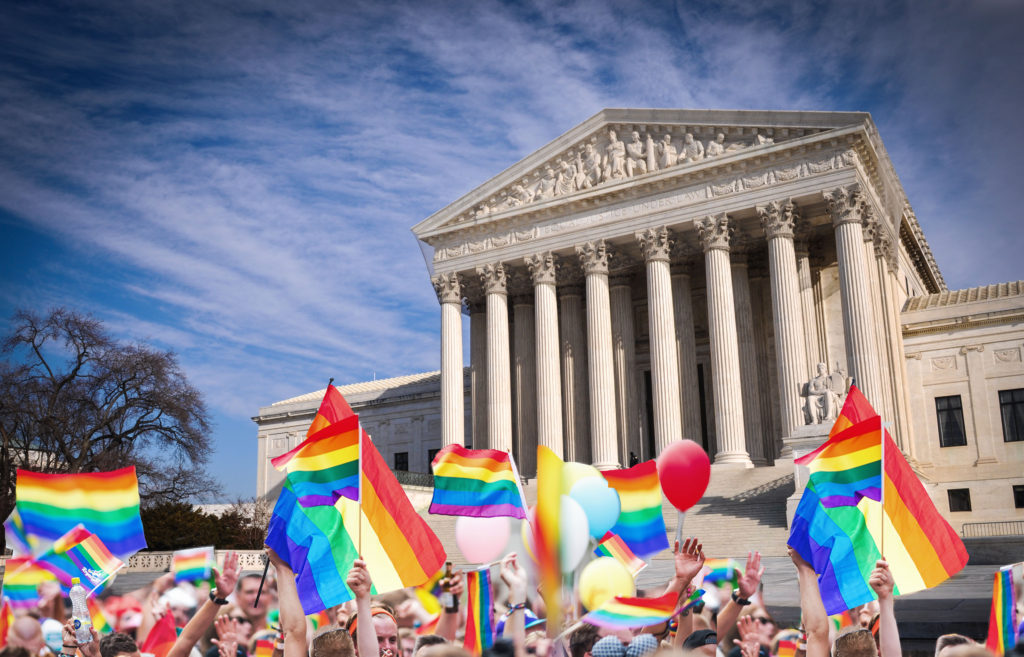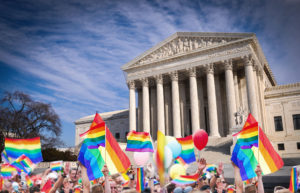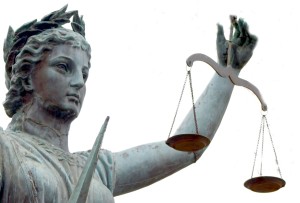
By Zeliang Mike Liu
On June 15, 2020, the Supreme Court issued a landmark 6-3 decision stating that Title VII of the Civil Rights Act of 1964 (“Title VII”) prohibits an employer from firing an individual for being homosexual or transgender.[1] The question came to the court through three different cases: Bostock v. Clayton County, in which a child welfare advocate was fired for participating in a gay recreational softball league after ten years working for a Georgia county; Altitude Express v. Zarda, in which a skydiving assistant was fired after he told a female customer that he was gay, and the customer’s boyfriend complained that he inappropriately touched her; and R.G. & G.R. Harris Funeral Homes v. Equal Employment and Opportunity Commission, in which a funeral home employee was fired when she informed the funeral home that she decided to undergo gender reassignment surgery.[2] Writing for the majority, Justice Neil Gorsuch stated that “it is impossible to discriminate against a person for being homosexual or transgender without discriminating against that individual based on sex.”[3]
Though the court’s focus in Bostock was the issue of employers discharging employees based on sexual orientation and transgender status, the court arguably provided a broad ruling with impacts to multiple areas of the law. As Justice Samuel Alito stated in his dissent, the Court’s ruling is “virtually certain to have far-reaching consequences” and will inevitably affect other federal laws, such as Title IX of the Education Amendments of 1972 (“Title IX”), the Patient Protection and Affordable Care Act (“ACA”), and the Fair Housing Act (“FHA”).[4] The implication of Bostock is not only protection of LGBTQ+ rights in employment, but an essential tool to address discrimination against LGBTQ+ community members not just in education, healthcare, and housing.
Employment
Workplace discrimination against LGBTQ+ community members is well documented. Between 8–17 percent of LGBTQ+ workers and 13–47 percent of transgender workers have been denied employment opportunities or unfairly discharged because of sexual orientation or transgender status.[5] Nearly 30 percent of LGBTQ+ workers of color reported that they have experienced employment discrimination for sexual orientation.[6]
Title VII prohibits employment discrimination based on an individual’s sex.[7] The statute extends beyond discharging and applies when employers “fail or refuse to hire or to discharge any individual, or otherwise to discriminate against any individual with respect to his compensation, terms, conditions, or privileges or employment.”[8]Under Title VII, “compensation” includes not only wages but also benefits such as overtime pay, life insurance, vacation and holiday pay, and bonuses.[9]
The Supreme Court’s decision in Bostock directly affects employment practice with regard to an employee’s sexual orientation or transgender status. In its reasoning, the Court stressed that “discrimination based on homosexuality or transgender status necessarily entails discrimination based on sex.”[10]Thus, although the individual cases before the Court focused on the wrongful termination of LGBTQ+ workers, the Court nevertheless determined that under Title VII protects against broader discrimination based on sexual orientation and transgender status.[11]
Although the Court specifically stated that its decision in Bostock does not “address bathrooms, locker rooms, or anything else of the kind” when addressing employers’ concern of whether sex-segregated spaces violate Title VII,[12]the Court’s decision does extend to equal access to existing sex-segregated facilities, meaning that an employer cannot deny an LGBTQ+ worker from access to the existing sex-segregated facilities.[13]
Education
Title IX prohibits discrimination “on the basis of sex” in any education program or activity that receives federal funding.[14]Although the statue does not define the scope of discrimination “on the basis of sex,” courts have often looked at cases that define the scope of sex discrimination under Title VII to interpret the meaning of discrimination “on the basis of sex” under Title IX because of the similarities between Title VII and Title IX’s language.[15]The Fourth, Sixth, and Seventh Circuit Courts of Appeal, have all previously held that Title IX prohibits discrimination based on sexual orientation and gender identity by extending decisions that stated Title VII prohibits discrimination based on sexual orientation and gender identity prior to the Supreme Court’s decision in Bostock.[16]
Therefore, Bostock’s holding that Title VII prohibits discrimination based on sexual orientation and transgender status provides further assistance for courts to extend Title IX’s protections for LGBTQ+ students.
Housing
The FHA prohibits discrimination in the sale, rental, and financing of housing based on race, color, national origin, religion, sex, familial status, and disability.[17]Similar to Title IX, courts often look to Title VII when determining the scope of prohibited sex discrimination under FHA.[18]Thus, courts are also likely to extend Bostock to FHA and offer greater protection on LGBTQ+ rights under the FHA.
The Trump administration issued a proposal in July 2020 to limit the 2016 Equal Access Rule and allow housing programs funded by the U.S. Department of Housing and Urban Development (“HUD”) to deny shelter access based on transgender status.[19]In light of the Bostock decision, Reps. Jennifer Wexton and Maxine Waters submitted a letter to Dr. Ben Carson, Secretary of HUD, to revise the proposal in accordance with Supreme Court’s holding in Bostock.[20]However, Dr. Carson stated in response that “[t]he Supreme Court’s ruling in Bostock has no impact on the Department’s proposed rule.”[21] HUD’s apparent refusal to take Bostock highlights a next step in the path forward for LGBTQ+ rights.
Healthcare
Section 1557 of the ACA prohibits discrimination on the basis of race, color, national origin, sex, age, or disability in certain health programs or activities.[22] The nondiscrimination language in Section 1557 was built on other federal civil rights laws including Title VII, Title IX, the Rehabilitation Act of 1973, and the Age Discrimination Act of 1975.[23] Thus, since the Supreme Court held in Bostock that Title VII forbids discrimination based on sexual orientation and transgender status, such holding likely carries significant weight in application to ACA.
In 2016, the Obama administration promulgated a rule stating that Section 1557 of ACA prohibits discrimination in health activities and activities on the basis of sexual orientation and gender identity.[24] Earlier this year, the Trump administration proposed a rule to exclude ACA’s protection on sexual orientation and gender identity, and four days after the Bostock decision, the Department of Health and Human Services issued its final rule.[25] However, on August 17, 2020, one day before the rule was planned to go into effect, a federal judge issued a preliminary injunction, which barred the rule from going into effect, relying on the Supreme Court’s decision in Bostock.[26]The recognition of the interplay between Title VII and the ACA provided further assurance on Bostock’s positive impact on ACA.
The Supreme Court’s decision in Bostock is a great victory for LGBTQ+ community that’s worth celebrating. Although the fight for LGBTQ+ rights is not over, Bostock nevertheless demonstrates that the LGBTQ+ community has advanced powerful arguments that even the Supreme Court’s most ardent textualist supports. Similar text in other federal statutes provides a path forward for future solidification of LGBTQ+ rights.
[1] See Bostock v. Clayton Cnty., 140 S. Ct. 1731, 1737 (2020).
[2] Id. at 1737–38.
[3] Id. at 1741.
[4] Id. at 1778 (Alito, J., dissenting).
[5] Ctr. Am. Progress et al., A Broken Bargain: Unchecked Discrimination Against LGBT Workers 1 (2014), https://www.lgbtmap.org/file/unchecked-discrimination-against-lgbt-workers.pdf.
[6] Nat’l Pub. Radio Et Al., Discrimination in America: Experiences and Views of LGBTQ Americans 11 (2017), https://cdn1.sph.harvard.edu/wp-content/uploads/sites/94/2017/11/NPR-RWJF-HSPH-Discrimination-LGBTQ-Final-Report.pdf.
[7] 42 U.S.C. § 2000e-2(a).
[8] Id.
[9] U.S. Equal Emp’t Opportunity Comm’n, EEOC-NVTA-0000-12, Facts about Equal Pay and Compensation Discrimination (1997), https://www.eeoc.gov/laws/guidance/facts-about-equal-pay-and-compensation-discrimination.
[10] Bostock v. Clayton Cnty., 140 S. Ct. 1731, 1747 (2020).
[11] See id.
[12] Id. at 1753.
[13] The U.S. Equal Employment Opportunity Commission (“EEOC”) has established that a transgender employee’s right to use woman bathroom is protected by Title VII. Lusardi v. McHugh, E.E.O.C. Doc. No. 0120133395, 2015 WL 1607756, at *7 (Apr. 1, 2015).
[14] 20 U.S.C. § 1681(a).
[15] See, e.g., Whitaker ex rel. Whitaker v. Kenosha Unified Sch. Dist. No. 1 Bd. of Educ., 858 F.3d 1034, 1047 (7th Cir. 2017); Smith v. Metro. Sch. Dist. Perry Twp., 128 F.3d 1014, 1022–23 (7th Cir. 1997).
[16] See Whitaker, 858 F.3d at 1047–49; Dodds v. U.S. Dep’t of Educ., 845 F.3d 217, 221 (6th Cir. 2016) (noting that Title VII’s prohibition on discrimination based on sexual non-confirming behaviors is applicable in the context of Title IX); Grimm v. Gloucester Cnty. Sch. Bd., 400 F. Supp. 3d 444, 451-52 (E.D. Va. 2019), aff’d, No. 19-1952, 2020 WL 5034430 (4th Cir. Aug. 26, 2020), as amended (Aug. 28, 2020).
[17] 42 U.S.C. § 3604(a).
[18] See, e.g., Smith v. Avanti, 249 F. Supp. 3d 1194, 1200 (D. Colo. 2017) (“The Tenth Circuit looks to Title VII discrimination cases for guidance in addressing discrimination issues under the FHA.”).
[19] Making Admission or Placement Determinations Based on Sex in Facilities Under Community Planning and Development Housing Programs, 85 Fed. Reg. 44,811, 44,811 (proposed July 24, 2020) (to be codified at 24 C.F.R. pt. 5, 576), https://www.govinfo.gov/content/pkg/FR-2020-07-24/pdf/2020-14718.pdf.
[20] See Press Release, U.S. House Comm. Fin. Serv., Walters and Wexton Call on HUD to Reconsider Revisions to Equal Access Rule (July 6, 2020), https://financialservices.house.gov/news/documentsingle.aspx?DocumentID=406742.
[21] Letter from Ben Carson, Sec’y, U.S. Dep’t Hous. & Urban Dev., to Maxine Waters, Rep., 43rd Cong. Dist., and Jennifer Wexton, Rep., 10th Cong. Dist. (July 13, 2020), https://wexton.house.gov/uploadedfiles/hud_response_to_waters-wexton_6.29.20_letter.pdf.
[22] See 42 U.S.C.§ 18116.
[23] Id.
[24] See Maya Rhodan, Obamacare Rule Bans Discrimination Against Transgender Patients, Time (May. 13, 2016), https://time.com/4329609/transgender-discrimination-obamacare-healthcare/; see also 45 C.F.R. § 92.207, https://www.govinfo.gov/content/pkg/CFR-2016-title45-vol1/pdf/CFR-2016-title45-vol1-sec92-207.pdf.
[25] See Dan Diamond, Trump Team Moves to Scrap Protections for LGBTQ Patients, Politico (Apr. 24, 2020), https://www.politico.com/news/2020/04/24/trump-team-moves-to-scrap-protections-for-lgbtq-patients-206398; see also Nondiscrimination in Health and Health Education Programs or Activities, Delegation of Authority, 85 Fed. Reg. 37,160 (June. 19, 2020) (to be codified at 42 C.F.R. pt. 438, 440, 406 and 45 C.F.R. pt. 86, 92, 147, 155, 156).
[26] Walker v. Azar, No. 20CV2834FBSMG, 2020 WL 4749859, at *10 (E.D.N.Y. Aug. 17, 2020).












